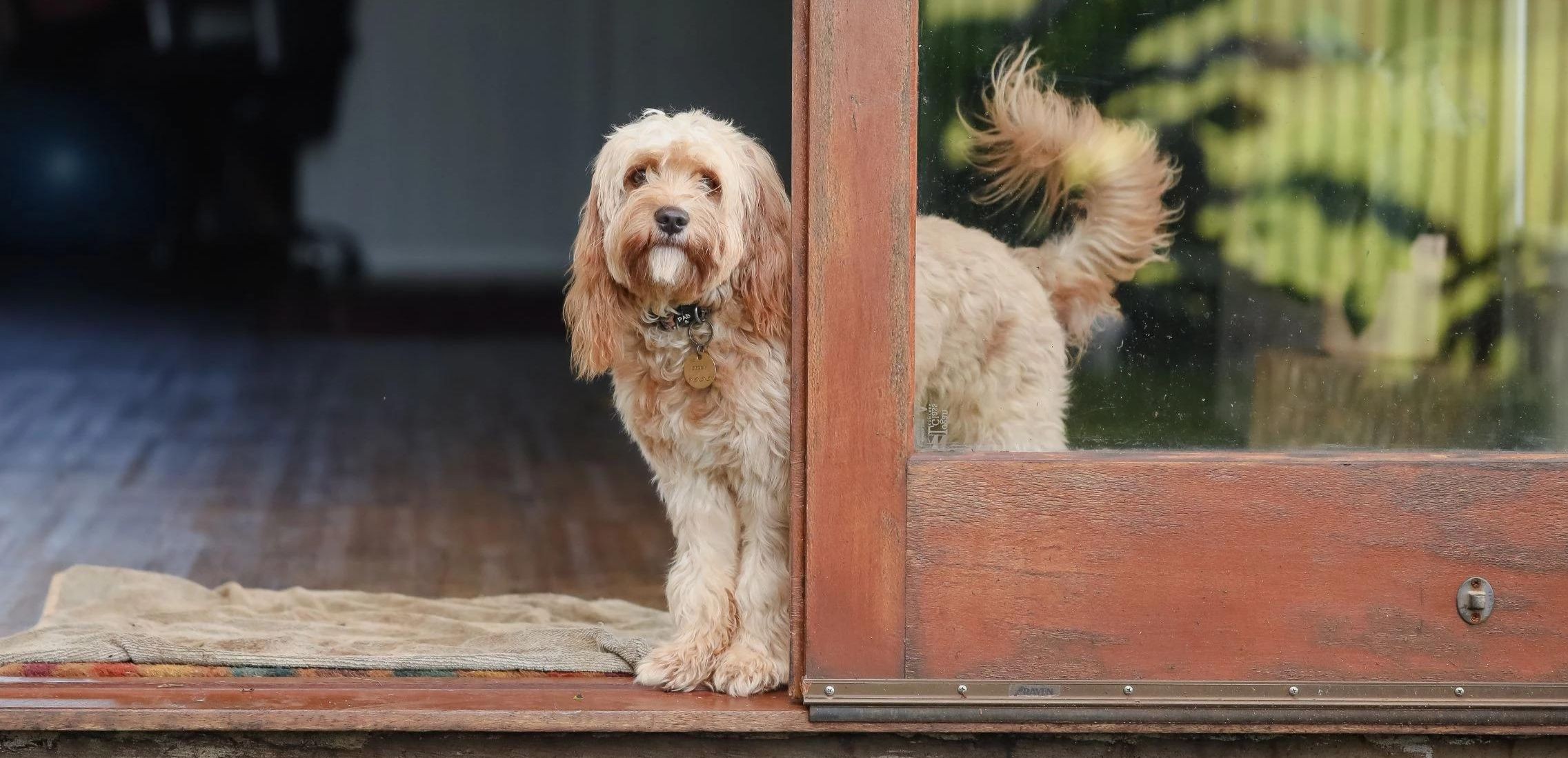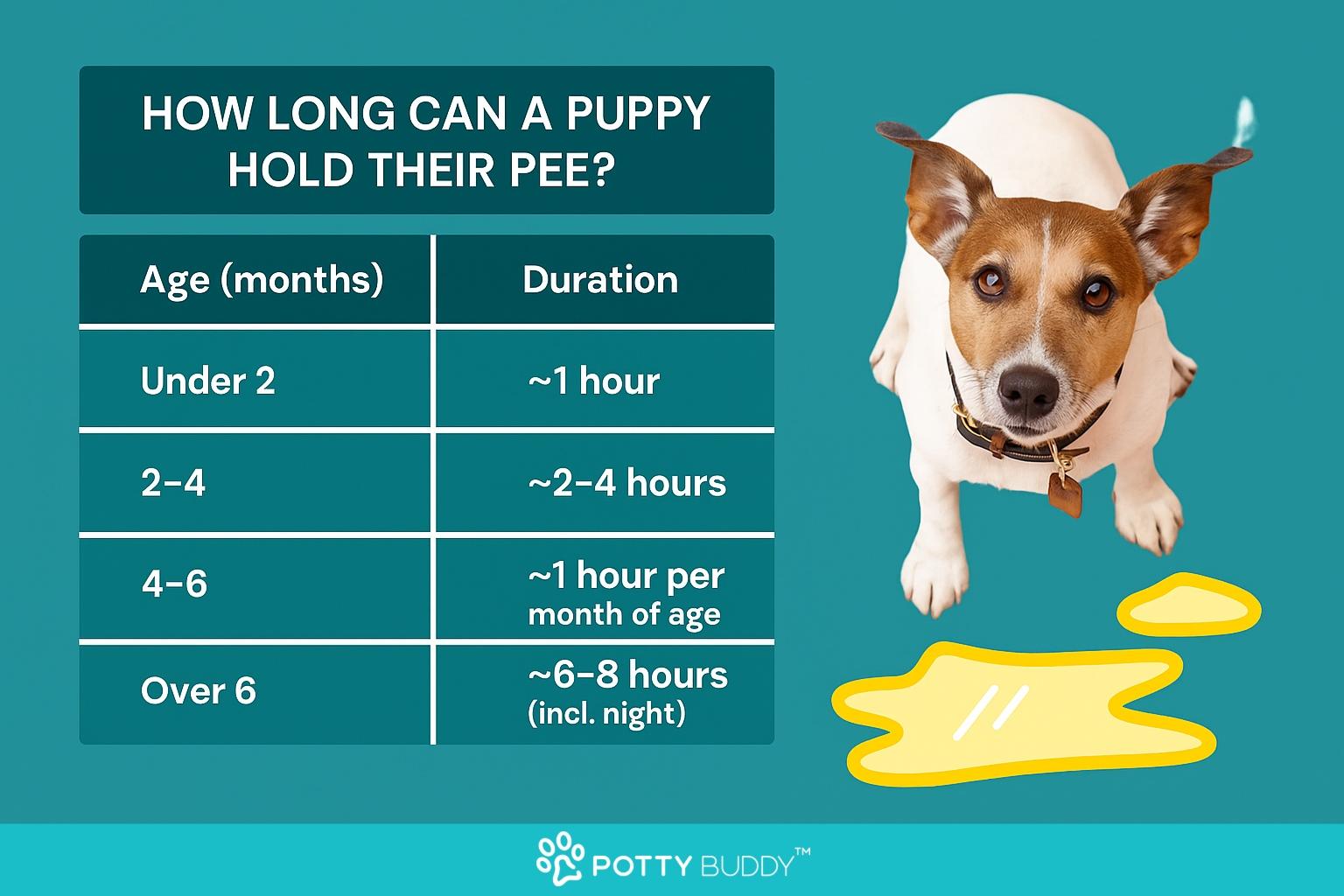Your Cart is Empty
Get Up To 35% OFF & Free Delivery
Get Up To 35% OFF & Free Delivery
Get Up To 35% OFF & Free Delivery

Teaching a pup to hold their pee is a necessity for house training. Whether it is through the night or being sure your dog can hold it while you are out for the day, monitoring how long your dog can hold their pee and training them to urinate in appropriate places is one of the main jobs of any pet parent.
Potty training can take time and patience, it isn’t going to happen overnight, and so being armed with as much knowledge as you can will stand you in good stead for the journey ahead.
In this blog we will talk about the factors that may affect how long your dog can hold its pee; from age and health to environment and water intake, there are many factors to consider during the potty training process, and Potty Buddy is on hand to help.
So, how long can dogs hold their pee? Let’s find out!

There are multiple factors that can contribute to how long dogs can hold their bladder. From the age of your dog, its health status, its diet and water intake, its environment, activity and play, to what stage of potty training it has reached.
We break down how each of these factors can influence how long your dog can hold their bladder, so you can better understand how to creative a supportive and healthy balance for your pup...
How long your dog can hold their pee is often dependent on their age, as typically the older (and larger) your dog is, the longer they should be able to hold their pee.
A puppy below 6 months can usually only hold it from 1-3 hours, meaning frequent toilet trips will be needed. Then as pups reach the 6 months and over mark they should then be able to hold their pee from anywhere between 2-6 hours.
Adult dogs below 7 years should be able to keep their pee in for about 6-8 hours. Older dogs - we’re talking senior dogs 7 years and older - will experience a decrease in their pee-holding power; meaning they will be able to hold their pee for approximately 4-6 hours, and later 2-4 hours when they reach 12 years or older.

Of course, this is a general guideline and you may find that as your own pup matures that they don’t necessarily strictly adhere to these guidelines (especially because, as we mentioned earlier, a number of factors can contribute to how long a dog can hold its pee.)
What’s most important is that your dog has regular access to go potty; whether that’s frequent potty breaks outdoors or using potty care accessories (like reusable pads) if you’re unable to let them outdoors due to being out at work etc. all day.

How long puppies can hold their pee will vary at different developmental stages:
Puppies who are under one month have pretty much zero control of their bladder, and so little messes come with the territory!
Coming up to the 3 month mark, pups will still be needing to pee pretty frequently and should be guided towards an appropriate pee pad or outdoor space one an hour, more if needed.
The 3-6 month mark remains within the once an hour rule, with a stretch to 2 hours as they get closer to 6 months.
This will then increase to 2-4 hours between 6-9 months old, and then 3-6 hours when pups reach the age of 9-12 months old.
Congratulations - you made it to the 1 year mark! By the time puppies are a year old they should easily be able to hold their pee for around 6-8 hours, meaning they can be left to their own devices for longer without the fear of coming home to rivers of pee!

Stating the obvious, smaller dogs will have smaller bladders. However, this does not necessarily mean that they will need to pee more frequently than larger dogs. Each dog is entirely unique and therefore will have different peeing needs!
Dogs pee an estimated amount of 10-20ml for each pound of their body weight. Depending on the size and weight of your dog, the approximate amount they will need to pee can be calculated to give you a rough idea of what your dog’s daily pee routine will look like.
If you want to calculate roughly how your dog’s size will impact how frequently they need to pee, here’s an example using the above calculation of:
1 pound of weight = will need to pee approx 10-20ml
So say your dog is around 5 lb, they will then need to pee anywhere between 1.7 and 3.5 oz per day.


Health will have a massive impact on a dog’s urinating habits. If your dog is in poor health, you may find that they pee more or less frequently.
If your dog is not peeing much, this could be a strong indicator that they are dehydrated or perhaps in discomfort when they pee. Urinary tract infections can be a nightmare for your pup, as they will have the urge to urinate frequently but it will be very uncomfortable.
If your dog’s toilet habits change, it is vital to monitor this closely as it is one of the first indicators that something could be going on internally.
And if you would like to learn more about whether puppies can experience bladder infections, check out our blog on the topic here.
What goes into your pup will naturally have an impact on what comes out. If you are feeding your dog on dryer foods then you will need to ensure that your dog is getting enough water to hydrate themself. Whilst in comparison, wet foods will offer a little more hydration in addition to their daily water intake.
When the weather gets warmer, water intake must be a top priority - be sure to monitor this closely and always make sure that your pup has access to clean, fresh water.
You may find that your dog is resistant to drinking water (especially with some rescue dogs), so to help encourage your dog to drink when they need to you can try adding a small drop of milk to your dog’s water bowl.


Your dog’s environment can be vital to their urination habits. If a dog doesn’t feel comfortable in their environment, they may refuse to pee. On the other side of this, if they feel anxious or scared then more frequent urination can occur.
Over-urination in particular can be a clear sign that your dog is feeling uneasy in their space.
It can also be a display of territorial marking, which can occur if your dog is entering a new space and wants to stamp their mark. Or if they smell an unfamiliar animal in their space and feel threatened.
Puppies in particular can forget themselves, and when they are in the middle of play or something exciting, they can forget to pee until the point where they can’t hold it any more, resulting in little accidents.
When playing with your puppy, it is important to give them regular pee breaks so that they get to know that peeing wherever they want is not allowed.
Make sure to have an established pee spot for your puppy and regularly take them to this spot, so they can begin to understand that this is where you want them to go.


Every potty training journey will be different, because all dogs are different! Some will take to it easily, while others might take a little longer getting the hang of things.
If your dog continues to pee frequently and in unwanted places, it could be a sign to go back to basics. Redirecting your dog back to desired toileting behaviors when things go awry is a good course of action.
Remember, when it comes to potty training your puppy, consistency and repetition is the name of the game. If you keep changing where and when your puppy goes toilet, this can be confusing for your dog and result in their going potty in undesirable places.
If in doubt, return to square one and start from scratch. But if your puppy continues to struggle with their toilet habits and training, consider reaching out to a qualified trainer or behaviorist for support, or reach out to your local veterinarian for advice.
Implementing a regular bathroom routine for your dog is SO important. Not only does it give you peace of mind that your home won’t be filled with puddles, it also reassures your dog that they will always have appropriate time and space to relieve themselves.
Urinary Tract Infections - It is vital that your dog is able to relieve themselves regularly to avoid complications with their internal systems. Similarly to humans, dogs can contract urinary tract infections from having to hold their pee for too long, which can be incredibly uncomfortable as well as lead to further medical issues, such as kidney stones.
Urinary Cancer - There are also more serious issues that could be causing your dog to urinate more frequently, and by having a regular bathroom routine for your dog it allows you to keep a closer eye on any changes or differences in their toilet habits.
Incontinence - As dogs get older they can start to suffer from incontinence, as well as becoming more prone to infections. More sinister issues such as urinary cancer often present themselves as a change in toilet habits, and so if you are in any doubt about your dog’s health, always consult your vet.


There are things you can do as a pet parent to keep your dog’s pee routine in check and make sure they are not relieving themselves when and where they shouldn’t:
Proper routine - Implementing a proper and regular toileting routine for your dog will teach them where and when to pee; as we’ve said before, repetition is key!
Commands and signals - Dogs respond exceptionally well to commands and signals, so having a verbal or visual cue to direct your dog to pee can come in handy.
Monitor food and water intake - The more water that goes in, the more that’s gonna come out!
Take them out at appropriate intervals - Be sure to take your pup out at regular intervals so they have the opportunity to relieve themselves. As dogs get older they will start to tell you when they want to go out, but some may need a little encouragement.
Get to know your pup - At the end of the day, no two pups are the same. Each one will have their own individual needs and toilet habits, so the best thing you can do is spend time with your pup and get to know them.
And there we have it!
Dogs can generally hold their pee for up to 6-8 hours, although this varies based on age, size, and health. Puppies and senior dogs may need breaks every 2-4 hours, while healthy adult dogs can typically wait longer. Frequent bathroom breaks are essential to prevent health issues and ensure the dog's comfort.
All dogs are different and so will present different potty training challenges, but by getting to know your pup’s individual quirks and needs, finding a toileting rhythm for your dog will be a breeze.
Don’t forget that our Premium Reusable Potty Pads are always handy to have in stock, to help offer your pup that extra protection if you can’t watch them 24/7.
See How Dog Owners Are Using These Leak-Free Potty Pads to Keep Their Homes Clean and Pups Happy
4.7 ⭐⭐⭐⭐⭐
Over 100,000 Dog Owners Saved Money With Potty Buddy™
The washable pee pads that absorb anything your dog throws at them, while keeping your floors and furniture stain-free.
✅ Super Absorbent and Leak-Proof
✅ Great for Potty Training
✅ Ideal for Puppies and Older Dogs
✅ Washable and Reusable For Years
✅ Save over $400/year by not buying disposables
-60 Day Money Back Guarantee-

⭐⭐⭐⭐⭐
-Diana D.
These pads are a life saver for my kitchen floor and bedroom carpet! Just ordered 2 more!




Follow Us On
Check Out Our Most Popular Content